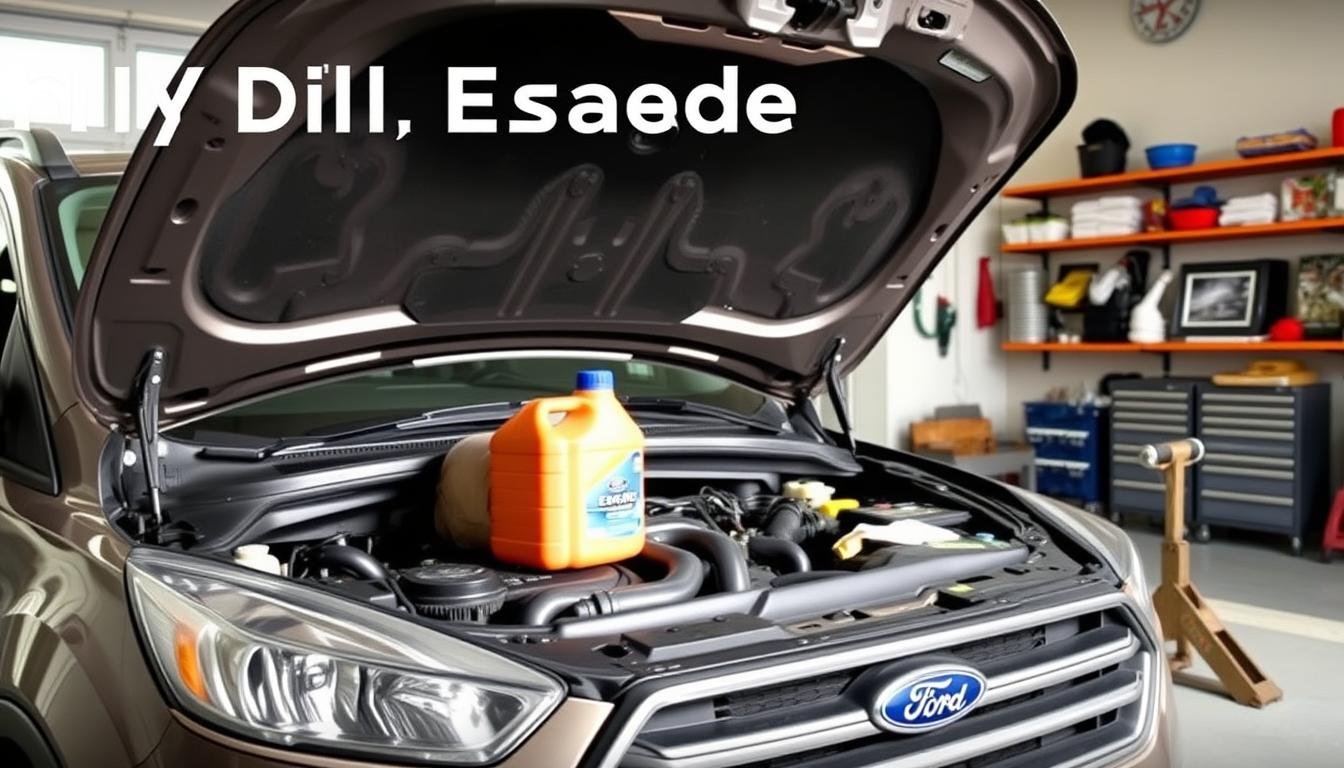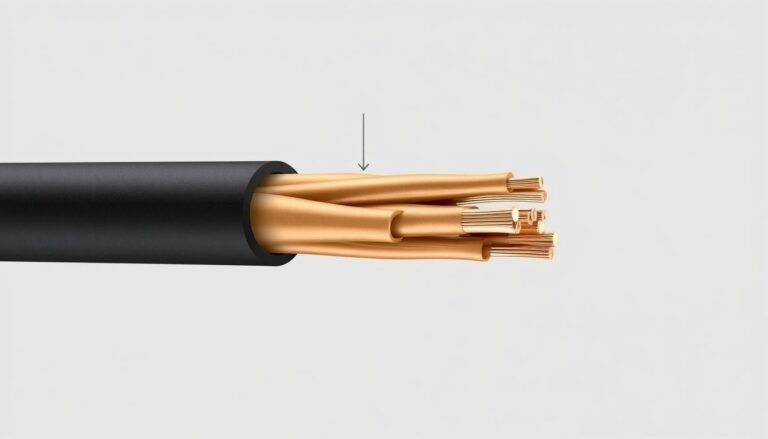Ford Escape Oil Change Better 7 Guide & Tips
How do you perform a Ford Escape oil change? This task is key to keeping your Ford Escape running well. Regular oil changes keep the engine clean and running smoothly.
This guide will help you do it yourself with confidence. You’ll find expert tips here, from picking the right oil to changing it.
You’ll learn when to change the oil, how to lift your vehicle safely, and how to dispose of used oil. By following our guide, you’ll save time and money and understand your vehicle better.
Introduction To Ford Escape Oil Changes
Changing the oil in your Ford Escape is key to keeping your car running well. This guide covers the basics of oil changes and why they’re important.
Regular oil changes help your engine run smoothly and efficiently. Oil changes get rid of sludge and debris that builds up.
If you don’t change the oil, your engine can wear out faster. This can hurt your car’s performance and shorten its life.
Importance of Regular Oil Changes
Regular oil changes are key to keeping your Ford Escape running well and lasting long. They involve draining out old oil and putting in new oil.
This keeps your engine running smoothly. Knowing the benefits of regular oil changes helps you take better care of your car.
Enhancing Engine Performance
Clean oil is essential for a good engine. It makes sure the oil in your engine can lubricate moving parts well. This reduces friction, making your engine run smoother and more efficiently.
By keeping up with oil changes, your car will have better throttle response and use less fuel. The engine will run better overall.
Prolonging Vehicle Lifespan
Regular oil changes protect your car’s lifespan. Oil acts as a shield for your engine’s parts, keeping them cool and reducing wear. Changing the oil regularly stops engine damage from dirt and sludge.
This careful maintenance can make your Ford Escape last longer. It keeps your car reliable for many years.
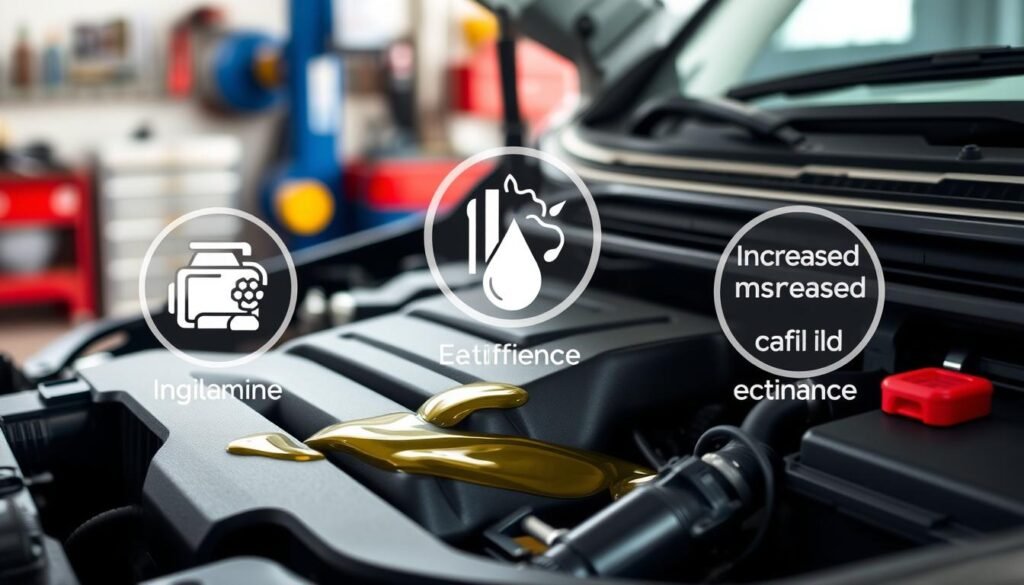
When To Change Oil in Your Ford Escape
Knowing when to change your Ford Escape’s oil is key to keeping the engine running well.
Regular oil changes keep the engine lubricated and catch problems early. This knowledge can make your driving better and extend your car’s life.
Recommended Oil Change Interval
The oil change interval for your Ford Escape is usually between 5,000 to 10,000 miles. This depends on the oil type and your driving habits.
If you drive in tough conditions, like heavy traffic or extreme weather, change the oil more often.
Signs That Indicate an Oil Change is Needed
Knowing the signs for an oil change can prevent engine troubles. Watch for these signs:
- Oil pressure light on the dashboard
- Unusual engine noises, like knocking or ticking
- Dark or dirty oil on the dipstick
- Excessive exhaust smoke
- More oil used than usual
Remembering these signs helps keep your car running smoothly and lasts longer.
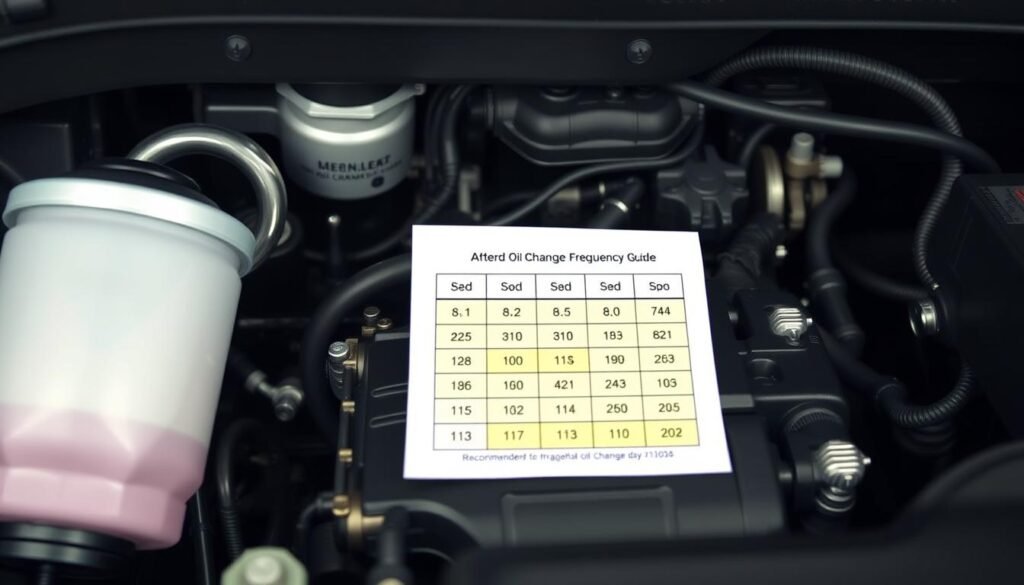
Ford Escape Oil Change Basics
Changing the oil in your Ford Escape needs the right tools and knowledge. Using the correct ford escape oil change tools makes the job easier and safer.
It’s also important to know which oil types are best for your car to keep it running well.
Essential Tools For The Job
To change the oil, you’ll need a few key tools:
- Socket set (15 mm and 7 mm)
- Ratchet
- Oil filter wrench
- Drain pan
- Funnel
These tools will help you replace the oil without making a mess.
What is Oil Types and Specifications?
Choosing the right oil for your Ford Escape is key to keeping the engine healthy. Most models do well with synthetic oil, like 5W-20, which Ford suggests.
Always check your owner’s manual for the right oil type, as different models may need different oils.
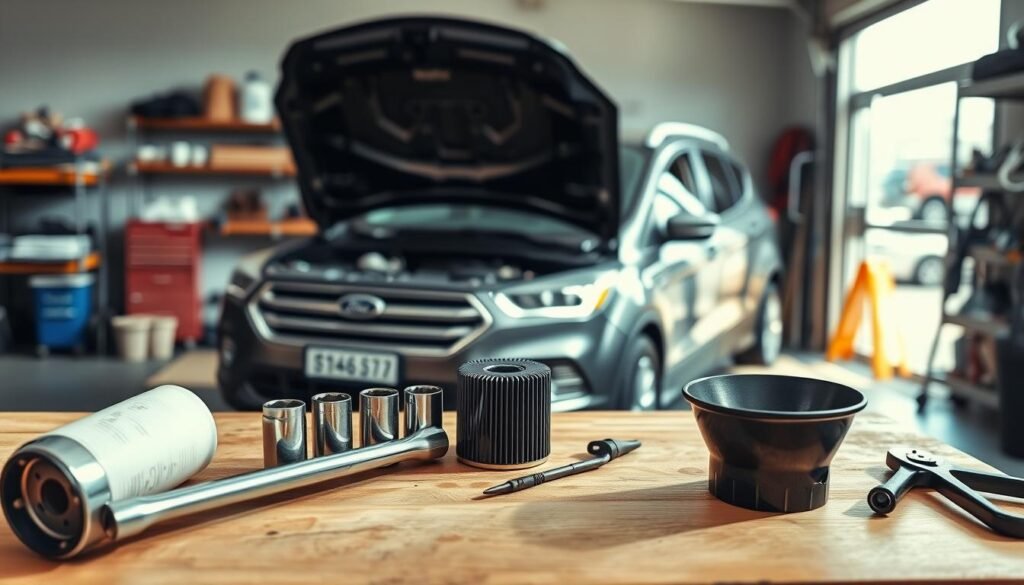
Gathering Necessary Materials
Getting ready for an oil change means collecting the right stuff. This keeps your Ford Escape running smoothly.
It’s important to use top-notch products for the best engine performance and to keep your car lasting longer. Below, you’ll find the best oil types and oil filters for your needs.
Best Oil For Ford Escape
Choosing the right oil for your Ford Escape is key. Look at Motorcraft synthetic blend or fully synthetic oil, depending on your model.
Both offer great protection and performance, no matter where you drive. Here’s a quick look at the recommended oils:
| Type | Features | Recommended For |
|---|---|---|
| Motorcraft Synthetic Blend | Balances performance and cost, suitable for general driving | Most Ford Escape models |
| Full Synthetic Oil | Offers superior protection and performance, ideal for high-stress driving | Sporty models or heavy-duty use |
Oil Filters: Options and Recommendations
Picking the right oil filter is just as important as choosing the best oil. Look for reliable filters like the Motorcraft FL910S or similar ones.
They help keep your oil clean and protect your engine. Here are some top picks:
| Oil Filter | Key Features | Fitment |
|---|---|---|
| Motorcraft FL910S | OEM quality, excellent filtration | Ford Escape (various models) |
| WIX 57060 | High dirt capacity, durable construction | Compatible with Ford Escape (select models) |
| Bosch 3330 | Multi-layer filtration, easy installation | Ford Escape (specific models) |
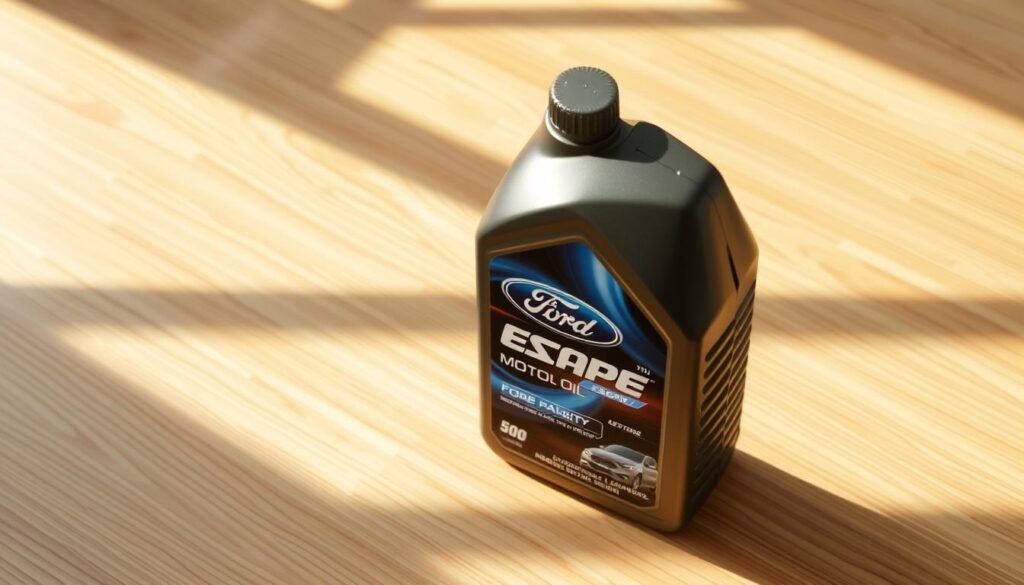
How To Change Oil in Ford Escape
Changing your Ford Escape’s oil is a key maintenance task. You can do it yourself with the right tools and knowledge.
This guide will help your car run smoothly. Remember, safety is key to avoid accidents while changing oil.
Step-by-Step Guide To Performing an Oil Change
- Get your tools ready, including new oil, oil filter, wrench, and oil drain pan.
- First, lift the car safely with jack stands.
- Drain the old oil by removing the oil drain plug and letting it flow into the pan.
- Replace the oil filter by unscrewing the old one and putting in the new one.
- Put back the oil drain plug once the oil is fully drained.
- Fill the new oil through the oil fill cap, following your Ford Escape’s recommended specs.
- Start the engine and let it run for a few minutes to mix the new oil. Check the oil level and add more if needed.
Precautions To Consider During an Oil Change
Before starting the oil change, remember these safety tips:
- Let the engine cool down completely to avoid burns.
- Wear gloves and goggles to protect yourself from oil.
- Make sure the car is safely lifted to prevent accidents or injuries.
- Dispose of used oil and filters at recycling centers.
Ford Escape Oil Change Procedure
Getting ready for your ford escape oil change is key. First, lift your car safely using ramps, a jack, and jack stands. This lets you work easily and safely under the car.
Preparation: Lifting The Vehicle Safely
Make sure your car is on a flat surface and the parking brake is on. Position ramps under the front wheels or use a jack to lift it.
Then, secure it with jack stands. Always protect yourself by making sure the car is stable before starting.
Draining the Old Oil
After lifting the car safely, find and remove the splash shield if your model has one. Look for the oil drain plug on the oil pan.
Start draining the old oil into a catch pan below. Let the oil drain fully. Then, clean up any extra oil around the drain plug area.
Changing the Oil Filter
With the old oil drained, it’s time to change the oil filter. Use an oil filter wrench to remove the old one carefully. Don’t let any oil spill.
Before putting on the new filter, apply some new oil to the rubber gasket. This helps it seal better. Place the new filter on and make sure it’s tight but not too tight.
Checking and Adding New Oil
After you’ve changed the oil, it’s important to check and add new oil to your Ford Escape. Knowing how much oil you need is key for your engine to run well.
Most Ford Escapes need about 5.7 quarts of oil, but this can change based on the model and engine type. Always check your owner’s manual for the exact amount you need.
How Much Oil Do You Need?
To find out how much oil you should add, look in your vehicle’s manual. It will tell you the right amount for your model.
Use a funnel to add oil to avoid spills. After adding oil, check the dipstick to make sure the level is right. This keeps your engine running smoothly.
Preferred Oil Types For Different Ford Escape Models
Choosing the right oil for your Ford Escape is important for its performance and life.
Synthetic or synthetic-blend oils are often recommended because they protect better and work more efficiently.
Always pick oil that meets or exceeds what your owner’s manual suggests for the best results.
Cost of Ford Escape Oil Change Services
Knowing the cost of oil changes helps you decide how to care for your Ford Escape. You can do it yourself or go to a dealership.
Each option has its own price, depending on several factors.
DIY vs. Professional Oil Change Costs
Changing the oil yourself costs between $30 to $60. This includes the oil and oil filter.
Professional services, though, cost between $70 to $120. Think about your time, skills, and warranty when deciding.
Estimating Oil Change Costs at Ford Dealerships
Dealerships offer more than just oil changes. They know your car well and use genuine parts.
The ford escape oil change cost at a dealership is usually the same, but prices vary. Compare these costs to DIY to see what’s best for you.
Environmental Considerations: Disposing of Used Oil
Handling used oil responsibly is key to protecting our planet. If we don’t dispose of it right, it can pollute our land and water.
As car owners, we must make sure to dispose of it safely. This means using the right methods and going to places that handle hazardous waste.
Safe Disposal Methods For Used Oil
To manage used oil disposal well, follow these steps:
- Store used oil in a leak-proof container.
- Avoid mixing used oil with other substances.
- Find local places to dispose of it, like automotive shops or recycling centers.
- Book a collection for used oil with your waste service, if they offer it.
Recycling Options For Oil Filters
Oil filters also need to be disposed of carefully to avoid harming the environment. Here’s what to do:
- Remove the oil filter carefully to avoid spilling any residual oil.
- Store the used oil filter in a designated container to prevent leaks.
- Look for places that recycle oil filters.
- Check with local waste management for recycling programs in your area.
By following these steps, we help keep our planet clean and healthy. And we also take care of our vehicle maintenance.
Conclusion
Regular oil changes are key to keeping your Ford Escape in top shape. Following the recommended schedule and knowing your model’s needs helps a lot.
This helps keep your engine healthy and boosts your car’s performance. Remember, oil changes are a simple yet vital task. They protect your engine from damage and wear.
Doing them right can also save you money over time. This guide is here to help you with oil changes.
By following these steps, you’ll keep your Ford Escape running well for many years. It’s all about being proactive and taking care of your car.
FAQs
Q: How often should I change the oil in my Ford Escape?
A: Most Ford Escapes need oil changes every 5,000 to 10,000 miles. This depends on how you drive and the oil type.
Q: What type of oil does my Ford Escape need?
A: Ford suggests using synthetic oil, like 5W-20. But, always check your owner’s manual for the best oil for your model.
Q: What are some signs that indicate my Ford Escape needs an oil change?
A: Look out for an oil pressure light, strange engine sounds, or dirty oil on the dipstick.
Q: How much does an oil change cost at a Ford dealership?
A: Oil changes at Ford dealerships cost between to 0. Prices vary by location and services.
Q: Can I perform an oil change myself, and what do I need?
A: Yes, you can do it yourself. You’ll need a socket set, ratchet, oil filter wrench, drain pan, and funnel. Also, get the right oil and filter for your car.
Q: How much oil do I need for a Ford Escape oil change?
A: Most Ford Escapes take about 5.7 quarts of oil. But, always check your owner’s manual for your model’s exact amount.
Q: What should I do with my used oil and oil filter?
A: Dispose of used oil and filters properly. Store used oil in a container and find a recycling center. Many auto shops accept used oil for recycling.

